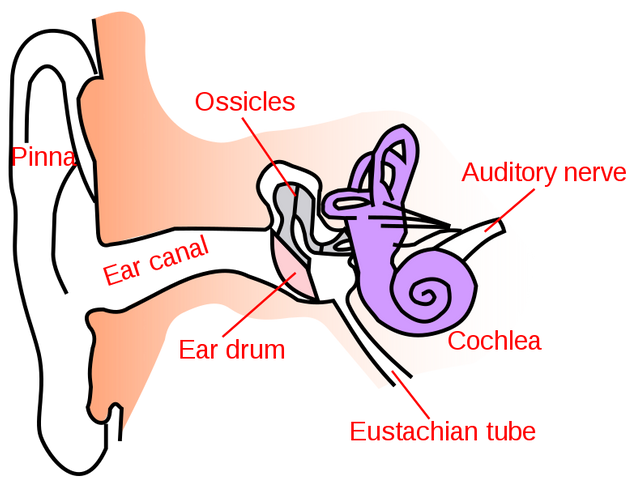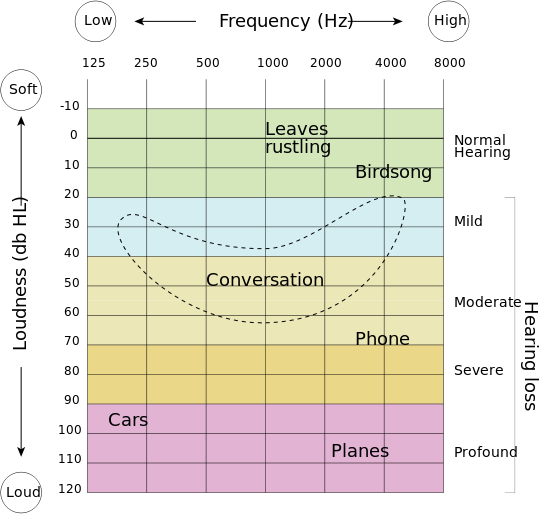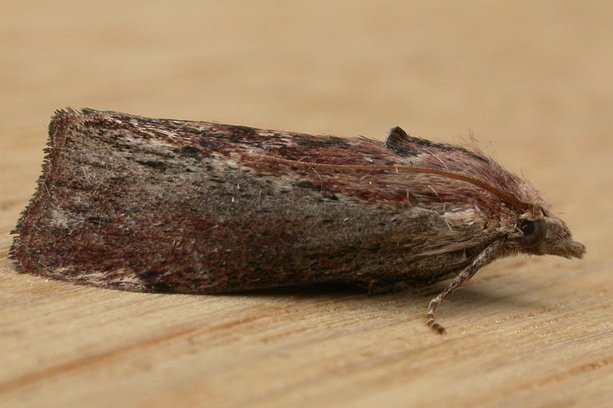Let's Learn Something Cool - What Sounds Can We Hear
Welcome to another educational post, steemians! A short catch-up from the previous episode on sound: Sound is a wave that propagates through a medium (gas, liquid or solid). It has speed, frequency (high or low), amplitude (loud or quiet) and direction (longitudinal). Today we're dealing with hearing and more specifically the range of frequencies that different creatures can detect in their environment.

(Image source: pixabay.com)
How do we get to hear?
First we need a source to produce the acoustic stimulus. In other words, something to start vibrating. The sound waves produced travel through the air and reach our outer ear. The shape of our ears is such that it can "capture" those waves and lead them through the ear canal to the middle ear. There they meet the eardrum and cause it to vibrate. Those vibrations are transferred through the ossicles (three tiny and very delicate bones) to the inner ear. That's where they find the cochlea, a small circular tube covered with tiny hairs. Those hairs start vibrating and their vibrations are then transmitted to the auditory nerves which lead them to the brain for extra processing (It's funny, isn't it? Our ears are basically antennae and our brain is a decoder of the signals those antennae capture).

(Image source: commons.wikimedia.org)
People have a very specific hearing range. You can find considerable differences among individuals, but on average the human ear is built to conceive sounds from 20 to 20,000 Hz.
What is that supposed to mean?
Hertz is the measuring unit of sound frequency. Frequency is determined as the number of complete waves (or vibrations) per time unit and one Hertz equals with one wave per second. Having the human hearing range as a reference point, we call all sounds with frequencies below 20 Hz infrasounds and sounds with frequencies above 20 kHz ultrasounds. Remember that the frequency of a sound is what we also call the pitch or tone.
Deviations from the rule
To measure one's hearing capacities we use an audiogram, a graph that depicts the pitch and volume a person can perceive. Hearing tests are conducted in sound-proofed rooms where the person responds to an acoustic stimulus by pressing a button when they hear a sound through their set of headphones.

(Image source: commons.wikimedia.org)
In this graph you can see the loudness on the y axis and the pitch on the x axis. As we said, we measure frequency in Hz. Loudness is measured in decibels (dB). The intensity of a sound is also related to the distance from its source, so a sound can be really loud but we cannot hear it if we stand too far from its source. Long exposure in loud sounds (above 85dB) can lead to hearing loss, but damage and pain is instantaneous after direct exposure to sounds of 140 dB and above.
Now, our ears are more sensitive to pitches within the 2-5,000 Hz range and we can hear sounds as quiet as 0 dB. When it comes to hearing loss that accompanies ageing, the higher pitches are the ones that start fading making the satisfaction of listening to a bird's chirping, for example, a thing of the past. Women also seem to lose this ability later than men.
Do animals hear the same as we do?
Not all creatures of the animal kingdom share the same hearing abilities. There is no way you'll be hearing the same sounds as your dog or a dolphin in an aquarium. According to a rule with many exceptions, smaller animals tend to hear higher frequencies and larger animals lower frequencies. The shape of their ears also seems to be related with the frequencies animals can hear.
![]()
(Image source: maxpixel.freegreatpicture.com)
We all know of the special ultrasonic whistles used in dog training (or simply from dog owners that want to drive their pets crazy). Those whistles are inaudible for humans because they produce sounds in very high frequencies. Cats have an excellent hearing too, but the creatures with the most acute hearing on the planet are...bats. Even though they have a great range of hearing frequencies depending on the species (1-200 kHz), they are best at detecting sounds within the 15-90 kHz range. Most of us already know that bats work like sonars and use echolocation to move around (they actually produce sounds and detect objects around them by the returning signals).
Still there's another creature that beats bats
Gypsy moth, Lymantria Dispar from North America can hear up to 150 kHz sounds. However, Galleria Mellonella, the greater wax moth, is the champion of the animal kingdom in this hearing competition. The beautifully ugly moth can detect sounds as high as 300 kHz. Those critters have made scientists want to re-evaluate their conclusions and run new studies on bat and moth hearing abilities.

(Image source: commons.wikimedia.org)
References
kidshealth.org
wikipedia_Hearing_range
wikipedia.org_Sound
science.howstuffworks.com
hypertextbook.com
global.widex.com
soundphysics.ius.edu
nature.com

Thank you for stopping by and giving this post a read. I hope you enjoyed it! If you please, feel free to pay a visit to my blog and check out my short stories along with plenty of educational posts and of course my bizarre natural phenomena series.


Until my next post,
Steem on and keep smiling, people!

Hi @ruth-girl,
Congrats! Your post has been featured in The Daily Qurator #43. I hope you like it.
Your Quality Curator,
Dr. TLK :D
Thanks!! I'm off to read that! :)
You are welcome :)
awesome post Ruth! I learned new things about hearing today :)
Thank you @mcfarhat!! I'm happy that my post got you things you didn't know.
Bats and moths would make a nice misconceptions post ;)
I love biology, sometime :p
support for your great post :)
Thank you my friend @kharrazi! :)
This post has received a 0.63 % upvote from @drotto thanks to: @banjo.
Well, bats eat moths, so... :P
Hey, I meant beats bats in this hearing contest
I guess bats hate to lose... :P
😄
when i saw this word "Let's Learn Something Cool" with image cover, i think you will teach me ninja frog dance. ;)
Ninja frog dance?! Ahahahahahahaha!!
Naaah! But if you'd like I could teach you Kalamatiano and tsamiko (greek traditional dances) :P
you would teach me with a video right ?, nice idea i can to dance in front of my mirror, hehe
This post has received a 2.24 % upvote from @buildawhale thanks to: @ruth-girl, @giosou. Send at least 0.50 SBD to @buildawhale with a post link in the memo field for a portion of the next vote.
To support our curation initiative, please vote on my owner, @themarkymark, as a Steem Witness
Εύγε! resteem
Eυχαριστώωωωωω! :D
You always blow my mind... :D [k ektos apo efxoulides agapo k vatraxiaaa :D ] Thanks for the science girl ! K ena 100% e giati to aksizeis pos na to kanoume !!! :D
Ωωωω! Thank you so much dear @meanmommy33!!! :)
Χεχε! Η δασκάλα απ'την Ελλάδα θα σας μάθει πολλά στο steemit!
I wouldn't expect any less!! :*